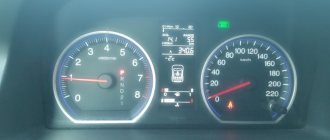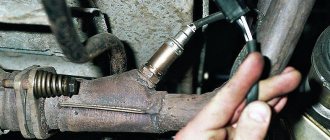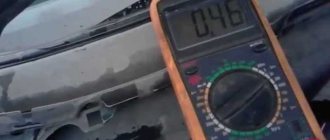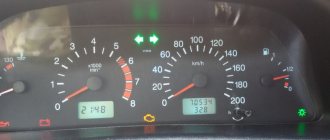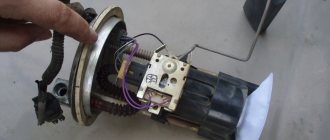Purpose
A lambda probe (oxygen sensor) is necessary for the normal functioning of ignition systems and the preparation of a combustible mixture. Measuring the oxygen content in the exhaust gases passing through the exhaust tract, it transmits the received data to the ECU. Pre-installed software processes the received information and optimizes the composition of the combustible mixture, as well as the ignition timing, which allows:
- Develop maximum engine power in all operating modes.
- Reduce fuel consumption.
- Reduce the content of harmful substances in exhaust gases.
This becomes possible when a stoichiometric combustible mixture containing fuel and oxygen necessary for its combustion in certain proportions enters the cylinders. Measured in kilograms, the optimal ratio of air to gasoline is 14.7:1, and in calculations is denoted by the letter λ (lambda), borrowed from the Greek alphabet. Hence the name - lambda probe.
Symptoms of malfunction
Where is it installed
By the behavior of the car, you can quite easily determine that the lambda probe has become unusable:
- The car jerks while driving;
- The revolutions are floating;
- The catalyst is not working properly;
- Fuel consumption increases noticeably;
- Exhaust gases contain a large amount of toxins.
The operation of this sensor requires constant monitoring. According to the operating manual, the check is performed every 10 thousand kilometers traveled. But if the operating conditions of the car are difficult, you have to regularly drive in difficult conditions, or the engine is overloaded, then it is better to check it more often.
Device
Structurally, the VAZ-2110 oxygen sensor is designed in the same way as similar devices installed on other cars. It consists of:
- Housings with a protective tip in which slots are made.
- Two electrodes, one of which (internal) is made of zirconium, and the other (external) is made of platinum.
- Wires with a connector with which the lambda probe is connected to the vehicle's on-board electrical wiring.
The principle of operation of the sensor is based on the potential difference between electrodes heated to 300 - 400 °C. The higher the difference, the less oxygen is contained in the exhaust gases.
Location
During production, changes were repeatedly made to the design of the VAZ-2110. Therefore, depending on the specific modification of the car, the lambda probe may be located in different places:
- In the upper part of the exhaust pipe, near the resonator (on models of early years of production).
- On the exhaust manifold, in front of the catalytic converter (on new 1.6 liter engines).
The latest models of cars, equipped with sixteen-valve engines, were equipped with two oxygen sensors, one of which is located in front of the catalytic converter, and the other behind it.
Symptoms of a problem
The main culprit for the failure of the lambda probe is low-quality fuel, due to which carbon deposits form on the electrodes, causing overheating of the contacts. Wire breaks occur less frequently. Most often, the driver finds out about a breakdown when the CHECK ENGINE lamp lights up, and computer diagnostics issues a fault code P0131. But it also happens that the ECU, for some reason, does not see the problem. In this case, the driver may suspect something is wrong, based on the following characteristic signs:
- Increased fuel consumption.
- Deterioration of the traction characteristics of the internal combustion engine.
- Unstable operation of the motor (vibrations, dips, floating speed).
If suspicion arises, it is necessary to first carry out a visual inspection. If there are no mechanical damages, control measurements should be taken.
Oxygen sensor malfunctions and error codes
Among the possible breakdowns of the lambda probe, the following can be distinguished: loss of sensitivity, non-working heating. As a rule, the on-board computer will not show you a breakdown if the problem is loss of sensitivity. It’s another matter if the heating circuit breaks, then the malfunction will be recorded.
- Error P1115 - a breakdown has occurred in the heating circuit
- Error P1102 - low resistance on the oxygen heater
- Error P0141 - the heater has broken down on the second sensor
- Error P0140 – sensor number two has broken
- Error P0138 - the second sensor indicates an excessive signal level
- Error P0137 - the second sensor indicates a reduced signal level
- Error P0136 – there is a short circuit to ground of the second sensor
- Error P0135 - the heater on the first sensor has failed
- Error P0134 – the first sensor has no signal
- Error P0133 - the first sensor responds slowly to the request
- Error P0132 – there is little oxygen in the system, the signal is high at the first sensor
- Error P0131 – there is a lot of oxygen in the system, the signal is low at the first sensor
- Error P0130 - the first sensor sends incorrect signals
Examination
To detect faults, it is best to visit a service center and seek help from diagnostic mechanics who have special equipment at their disposal. If this is not possible, you can arm yourself with a multimeter and perform a series of control checks. To do this you will have to:
- Attach thin needles to the tips of the multimeter. They are necessary in order to take measurements without disconnecting the sensor from the electrical wiring.
- Warm up the engine to operating temperature. Only in this case will the lambda probe begin to function, and the results obtained will be correct.
- With the ignition on, measure the voltage between the signal (black) wire and ground (gray wire). On the connector these are terminals 1 and 2. It is normal if you get a reading of 0.45 - 0.50 volts.
- Measure the resistance between the white wires (terminals 3 and 4). It should be in the range from 2 to 10 ohms.
- Start the engine and measure the voltage between the signal wire and ground again. It should change cyclically, every 1.5 - 2 seconds, within 0.1 - 0.9 volts.
If at least one of the indicators is outside the specified limits, the lambda probe is faulty and should be replaced. Measurements taken with the connector disconnected from the electrical wiring may be incorrect.
Checking the oxygen sensor (lambda probe)
If signs of failure are present, the sensor should be checked. It is best to do this at a service station, since self-checking with a voltmeter may give incorrect data if the sensor is not warmed up enough.
If you decide that the reason for the malfunction of the car was a malfunction of the lambda probe, then first inspect the part.
Instructions for inspecting the oxygen sensor:
- Pay attention to the wires. They should not be damaged or defective.
- Check to see if the connectors are firmly connected.
- Inspect the lambda probe for the presence of soot. If it is, this means the heater is not working properly, or the air-fuel mixture is too rich.
- Look to see if there is a shiny coating on the parts. It can indicate excessive lead content in the fuel poured into the tank.
The easiest and most convenient way to check the air sensor yourself is to check with a multimeter. These devices help estimate the voltage in the sensor. If there is soot, soot or mechanical damage on the oxygen sensor, then there is no need to check the sensor - it will need to be replaced in any case.
Lambda probe testing steps:
- Warm up the car by turning on the engine.
- If after inspection no defects were found, then you can connect a voltmeter or multimeter and begin checking.
- Reach 2 thousand rpm by pressing the gas pedal in neutral. After this, remove your foot from the pedal.
- Remove the vacuum tube from the fuel pressure regulator.
- Evaluate the voltmeter readings. They should be above 0.8 Volts. If the result is less, then the lambda probe is faulty.
The mileage for the lambda probe on the VAZ 2110 is limited. The maximum mileage is in the region of 100-150 thousand kilometers. However, experts advise replacing the sensor more often - every 60-80 thousand kilometers. Timely replacement of the lambda probe will reduce the amount of toxic exhaust gases and extend the service life of the catalyst.
Price
Even on a VAZ-2110 of the same year, there are oxygen sensors not only with different catalog numbers, but also from different manufacturers. Most often this is Lada 2112-3850010-20. Prices for this part in stores range from 2200 – 3200 rubles. But you can also choose a replacement from a reputable brand. Among the possible options:
- Bosch 0 258 006 537 (2300 – 2700 r).
- NGK 1628 (2500 – 2800 r).
- Era 570023 (1700 – 2000 rubles).
All these components will normally fulfill their purpose.
Replacement
To remove/install the lambda probe, you must first warm up the engine to operating temperature and then turn it off. It is very difficult to unscrew the part when it is cold. After reaching the desired temperature, be careful not to get burned:
- Disconnect the connector.
- Armed with an open-end or socket wrench, first move the sensor from its place, and then unscrew it and carefully remove it from the socket.
- Make sure the socket is not damaged. Sometimes scale mounds form in it, which can damage the new part during installation. If there are any, they will have to be removed with a file.
- Install the new sensor and tighten it properly.
- Connect the connector to the electrical wiring.
If you do everything correctly, no problems should arise.
Repair
Diagnostics
The VAZ 2110 lambda probe has four outputs:
Pads for VAZ 21102
Checking the oxygen sensor heater comes down to a basic check of the heater circuit:
- the presence of voltage at the power contact of the vehicle’s on-board network (if there is no voltage, check the entire circuit);
- presence of continuity of the negative contact circuit.
In the future, we are exclusively interested in the signal wire, or rather, the change in voltage passing along it from the sensor to the ECU during various engine operating modes. You can check the operation of the sensor in two ways:
- Using a voltmeter;
- Using an oscilloscope (motor tester).
Since this instruction is intended for the common man who simply cannot have professional equipment in principle, we will diagnose the sensor using a voltmeter.
Method one: reading trouble codes
In order to read the fault codes located in the controller’s memory, it is necessary to either connect special diagnostic equipment to the diagnostic block (located on the left side under the instrument panel console) (too simple - not for us), or close contact “B” to ground, which is so The same can be done by connecting contacts “A” and “B”.
Diagnostic block VAZ 2110
- “A” - contact connected to the vehicle ground;
- “B”—controller signal contact;
- “G” — control of the VAZ fuel pump;
- “M” is a contact for issuing information (serial data).
After these contacts are closed, turn the ignition key to position “III” (do not start the engine), observe the “CHECK” indicator, which should flash the number 12:
- Flash;
- 1-2 second pause;
- Flash;
- Flash;
- Long pause of 2-3 seconds;
- Double repetition of the above cycle.
Reading fault code number “12”
Attention! This code indicates that the self-diagnosis program is running, otherwise this program does not work.
After this, the program displays codes of existing faults in a triple cycle (each code three times), in the absence of these, code “12” continues to be displayed constantly.
Attention! When the diagnosis is completed, these contacts are allowed to be opened only after the ignition is turned off, after ten seconds.
Erasing fault codes from the ECU memory in order to make sure that the fault has been eliminated occurs by turning off the controller's power for at least ten seconds. The power is turned off either by disconnecting the negative terminal from the battery or by removing the controller fuse.
Attention! Operations with power supply to the controller must be carried out strictly with the ignition off!
Method two: checking changes in LP parameters
So, let's get to the “delicious” part:
- We connect the negative probe of the voltmeter to the car body;
- We connect the positive probe to the signal wire of the lambda probe;
- Warm up the engine to operating temperature;
- We warm up the sensor itself by setting the engine speed to 2500 - 3000 rpm for three minutes.
We observe the sensor:
- It must turn on, that is, the voltage must be in the range of 0.8 - 1.0 volts and turn on at a frequency of 8 - 10 times every ten seconds;
- If the voltmeter shows a value of 0.45 volts and it does not change, then the sensor does not work - replace it;
- When the damper is opened sharply, the voltage should jump to about one volt, and when closed sharply, it should drop to almost zero.
Method three: elimination method
Of course, all of the above methods are good, but without a clear understanding of the operation of the system, there is a high probability of making a mistake when diagnosing, as well as understanding the principle of wiring the block on a VAZ 21102. For example, the “loss” of code P 0131 (low level of the LZ signal) does not mean that the sensor began to “mope”, perhaps it really “sees” the “lean” mixture, because it only “monitors” the system - no more and no less. Therefore, there are checks that exclude these errors:
Situation 1
We have a “lean” mixture and a low voltage value at the output from the LZ. Examination:
- We “enrich” the air-fuel mixture by injecting gasoline into the intake pipe, or we pull out and then insert back the vacuum tube from the fuel pressure regulator, as a result, the speed should drop to 200 per minute;
- If the sensor instantly reacted by raising the voltage to 0.9 volts, then everything is in order, the reason should be sought in the car’s power system - there is simply not enough fuel. If the voltage changed slowly or stopped at 0.8 volts, the sensor should be replaced;
Situation 2
We have an “enriched” mixture. Examination:
- We make an artificial “suction” of air - remove one of the vacuum hoses;
- The voltage drops to 0.2 volts in less than a second, then the sensor is working;
- The voltage changes slowly or is above this value - faulty.
As we can see, these checks are quite simple and it is better to use them all in turn in order to eliminate errors in diagnosis, which is very important, since the price of a lambda probe does not allow you to “point your finger at the sky” when troubleshooting.
Advice! It is necessary to take into account that a slow response of the LZ to changes can occur due to the fact that misfires occur in the ignition system, as a result of which a large amount of unburned air-fuel mixture enters the exhaust manifold, which the LZ can regard as a deviation from the norm.
Advice! Air leaks in front of the LZ also affect its readings, which can lead to the following paradox: the LZ “talks” about a “lean” mixture, but in fact the mixture is “rich”, as a result of which the controller enriches the mixture even more. In this case, a gas analyzer will help you find out the truth.

